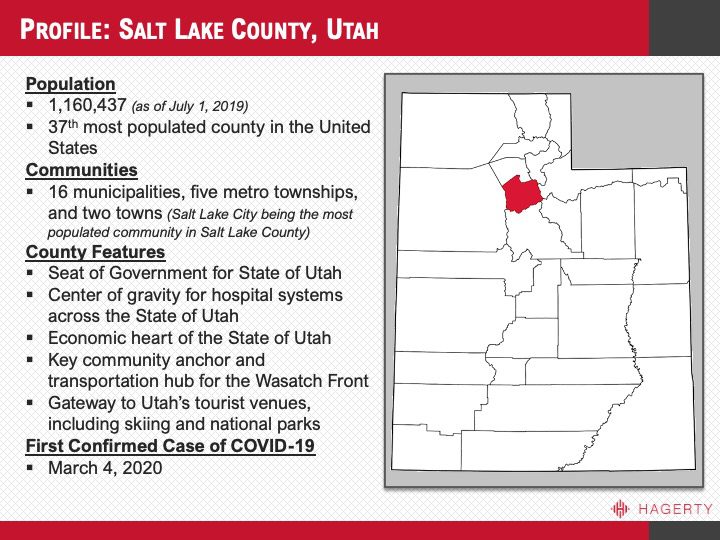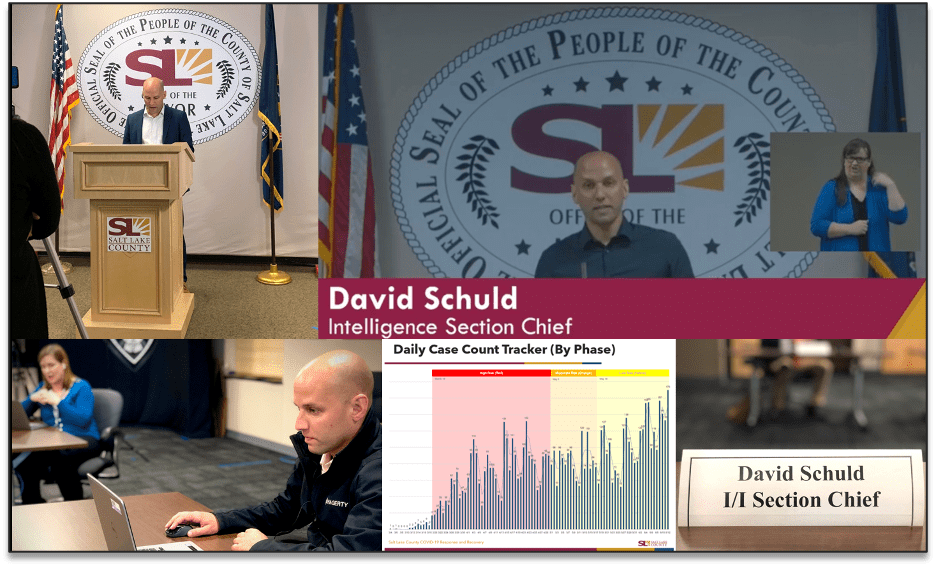THURSDAY, JUNE 25, 2020 AS OF 4:00 PM EDT
Over the past 110 days, I have been deployed to Salt Lake County, leading a team of Hagerty professionals supporting the emergent response, and early recovery effort happening here in Utah. The challenges had been unprecedented, and the collaboration, innovation, and dedication demonstrated by all responders – from those in the Emergency Coordination Center (ECC), to the quarantine and isolation facilities, hospitals, testing locations, firefighter crews, law enforcement personnel, and beyond – is exemplary of communities and partners rising to meet their objectives.

Profile of Salt Lake County, Utah
Salt Lake County’s first confirmed case of COVID-19 was documented on March 4, a date which seems ages ago. Over the past 100+ days, the County has been successful in maintaining pressure on the virus:
- We were concerned about the rate of cases increasing exponentially. High transmission rates of the virus between individuals would have a compounding impact.
- We were concerned of the hospital systems having to resort to crisis standards of care and collapse. The potential and ever-present threat of exponential growth could lead hospital beds, Intensive Care Units (ICUs), and ventilators to become a precious commodity. Overrunning these resources could lead to additional deaths.
- We were concerned that we could not understand the spread of the virus in the community. Understanding COVID-19 has been limited due to its novel nature. Knowledge of its characteristics continues to be explored and documented.
A key of being able and to continue to overcome these challenges has been the role of intelligence operations as part of Salt Lake County’s COVID-19 response.
Salt Lake County’s COVID-19 Response Intelligence Section
Understanding the value of data and information that is critical to informing evidence-based decisions has been a foundational pillar of Salt Lake County’s emergent response efforts. Two weeks into the response, Unified Command (comprised of the County Mayor, Director of Emergency Management, and Director of the Health Department) understood that a comprehensive intelligence capability was needed to support response efforts and established the Intelligence Section. As Intelligence Section Chief, my directives from Unified Command were clear:
- Conduct analysis of COVID-19 and its cascading effects in Salt Lake County.
- Develop comprehensive situational awareness by examining and monitoring trends and challenges that link Salt Lake County to the state, national, and global response.
- Work with the other Sections and provide action-oriented reporting to support the emergent response efforts.
- Ensure findings were being distributed to response partners.
Formation of the Intelligence Section based on the National Incident Management System (NIMS) and Incident Command System (ICS) seemed novel yet necessary for a pandemic emergency. Critical to our efforts were:
- Intent from Unified Command. Along with the directives mentioned previously, the Intelligence Section was provided milestones of success and a vision for products – key tenets of Intent from Unified Command. This Unity of Command from County leadership – trust with one another and the response teams; a forward-leaning, scientific-driven approach; and clear objectives to drive action – allowed the Intelligence Section to think creatively and collaboratively. Our efforts broke beyond merely understanding the trends of the virus but allowed us to study its impact on vulnerable populations, attrition of public safety agencies, and the reactivation of Salt Lake County.
- A Multi-Agency Approach. When information belongs to no one, its impact in a dynamic and uncertain response can be valuable to all. The Intelligence Section, while being attached to Salt Lake County’s Epidemiological Bureau, was not exclusively staffed by public health professionals. This unique relationship allowed epidemiologists to focus on disease surveillance, while creating a collaborative space for multidisciplinary analysis. Our team is multi-agency and has representation from firefighters, emergency management, law enforcement, and the Hagerty contract team. This approach facilitates deeper analysis into the behavior and effects of COVID-19 across Salt Lake County, including its communities, populations, public safety agencies, and hospital systems.
- Actionable Intelligence. The end products of the Intelligence Section could not be just a thesis of discovery or repackaging of another document. The products need to support or elicit an action focused on helping Salt Lake County’s response efforts. In the initial briefing with members of the Intelligence Section, a clear and simple phrase emerged: “So what?” Throughout our operation, the Intelligence Section challenged themselves and one another to produce intelligence notes and analysis that could be directly injected into and inform the decision-making process. Documents were designed to be short and get to the point, with additional materials accessible to operational leaders. Tomes of paper would get our Section Chiefs nowhere. This mindset of action, even in the “brain trust” of ICS Sections was key to helping Salt Lake County instill targeted interventions and strategic messaging into the response.

As Intelligence Section Chief, David Schuld led a multi-agency effort to collect information and produce analysis that would support the evidence-based decision-making process of Salt Lake County’s COVID-19 response. Activities included advising Unified Command, producing reports, participating in Command and General Staff meetings, and facilitating portions of briefings related to information and analysis.
Looking Back, Preparing for the Long Haul
Looking back through my days of being Intelligence Section Chief, the following initiatives come to mind in Salt Lake County being able to lean forward and counter the initial spread of the virus:
- Integration across major organizations. A key to our success in the initial weeks of response was an ability for major organizations across Salt Lake County to come together for a common cause. In events like a pandemic, time is a valuable resource. Relationships between leaders and agencies are key to being able to effectively address an incident. I applaud the professionalism and dedication of the traditional and non-traditional responders in Salt Lake County. I saw emergency management principles be applied to response. I also saw individuals such as librarians and arts and culture personnel lean forward in the interest of their community, becoming teams to support quarantine and isolation facilities, running Points of Distribution (PODs) for Personal Protection Equipment (PPE), and providing aid to high-risk and vulnerable populations. Ego has no place in an emergency incident, and it is critical that leaders instill this ethos prior to the response phase. We are all in this together.
- Planning, training, and exercises. Organizations in Salt Lake County had worked on building out plans that could support responding to a pandemic. Continuity of Operations (COOP) and comprehensive emergency management planning initiatives were key to those working in the ECC and in the field to have an understanding what they should be doing and how their actions impacted meeting objectives of the incident.
Exercises are also critical to refining capabilities, even now in the midst of the long haul of sustained response. Key to information sharing and analysis was Salt Lake County’s participation in Hagerty’s Hunter Seeker exercise. This innovative exercise places participating agencies into a multi-day exercise environment where intelligence operations can be refined and gaps in communication and coordination within the Information Sharing Environment (ISE) can be identified. Whether the incident scenario is a pandemic, an active threat, or a natural disaster like a wildland fire, exercises like Hunter Seeker are critical to strengthening information sharing capabilities.
Looking into the future, communities should plan for vaccinations and setting up and operating PODs. The challenges of these processes are immense for COVID-19. Communities should engage in advance planning and strengthen their operational readiness by assessing plans, developing training, and conducting exercises.
- Emphasis on enabling. I have mentioned this line once already, but it is worth restating: We are all in this together. Collaboration and a mindset of enabling the whole community to participate in response efforts is key. COVID-19 is unlike any other disaster before – no other incident in our nation’s history has had every state and territory in the United States (US) under a simultaneous Federal Disaster Declaration. .
No idea is a bad one. To Incident Commanders and Section Chiefs across the country: enable your teams to address challenges and find solutions, even if they have never been considered in emergency management before. The creativity and dedication I have seen here in Salt Lake County never ceases to amaze me. Empower teams, implement innovation (including the establishment of an Intelligence Section in a pandemic response), and respect the value your team members bring to the response. These are important characteristics of crisis leadership, and its value is even more accentuated with a sustained response.
More than 100 days in, I offer communities and responders across the country with these words of advice and perspective: our efforts to maintain pressure on the virus have only begun. At the time this Disaster Discourse was published, there is no treatment to COVID-19, and we do not have a vaccine. Our hard work in maintaining pressure on the virus to date has been contingent on the public’s participation in prevention and mitigation efforts, including practicing social distancing, wearing face coverings when social distancing is a challenge, and demonstrating health etiquette. The public has also been key in investigating spread of the virus through testing and contact tracing. As we move further away from the initial days of COVID-19 in our communities, we must overcome the fatigue of this long response with steadfastness and vigilance. The participation of the public, as well as maintaining strong intelligence capabilities, is key to our work. Our efforts continue to matter.
I want to thank all those deployed with me and working across the country and in their communities to respond to COVID-19. Keep up the fight…your dedication to the cause is seen every day.
David Schuld is a Deputy Director of Preparedness with Hagerty Consulting and is currently deployed to Salt Lake County to support COVID-19 response and recovery. Mr. Schuld served as Intelligence Section Chief for Salt Lake County’s emergent response to COVID-19, and has now been seconded as Special Assistant to the Mayor for COVID-19 Response and Recovery, supporting the sustained health response and the implementation of the adaptive and long-term recovery planning initiatives on behalf of the Mayor of Salt Lake County. Prior to COVID-19, Mr. Schuld led Hagerty’s Active Threat Portfolio, and is a nationally recognized leader in comprehensive and integrated response planning and operations. His policy experience includes serving as a military research analyst for the European Parliament in Brussels, serving as Military Legislative Assistant for a member of the US House of Representatives, political advisor to the British Army, and Crisis Management Advisor for the British Government in the US. Mr. Schuld is originally from Ohio, and studied political science at John Carroll University, has a graduate degree in public policy and administration from Katholieke Universiteit Leuven in Belgium, and completed Air Command and Staff College with the US Air Force.